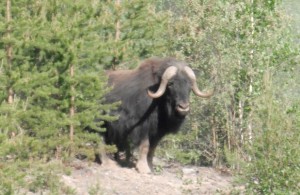Prehistoric Creature Seen, Photographed in Alberta
Posted by: Loren Coleman on June 14th, 2012

What did people see on Sunday, June 10, 2012?
Okay, the headline is “sensational” but “true.” I just wanted to demonstrate how actual sightings of a large, at-first unidentified animal can be transformed by the overblown re-visioning of a real incident.
Bernard Heuvelmans wrote of how human beings have a tendency to record and tell of the encounters with unknown new species by way of the use of fantastic descriptions.
A current example of that just occurred in Alberta.
In the Edmonton Journal of June 14, 2012, it was reported:
“When a large, brown animal was spotted near North Leland Lake in northern Alberta on Sunday, people assumed it was a moose. Maybe a bison.”
A local businessman told of how the people felt, upon seeing this animal.
“They were just overwhelmed to see that and very impressed,” said Dan Wettlaufer, owner of the Andrew Lake Lodge.
Well, a photograph was taken, and the species was immediately identified. It was a musk ox in Alberta, far from where it should be. It may have been the first sighting of a musk ox in Alberta in modern times.
“For the casual person that hasn’t seen one, you kind of have to imagine the combination of a bison and a woolly mammoth. They have a real unique prehistoric character,” said Wettlaufer.

Source. Thanks for newstip from Chad Arment.
About Loren Coleman
Loren Coleman is one of the world’s leading cryptozoologists, some say “the” leading living cryptozoologist. Certainly, he is acknowledged as the current living American researcher and writer who has most popularized cryptozoology in the late 20th and early 21st centuries.
Starting his fieldwork and investigations in 1960, after traveling and trekking extensively in pursuit of cryptozoological mysteries, Coleman began writing to share his experiences in 1969. An honorary member of Ivan T. Sanderson’s Society for the Investigation of the Unexplained in the 1970s, Coleman has been bestowed with similar honorary memberships of the North Idaho College Cryptozoology Club in 1983, and in subsequent years, that of the British Columbia Scientific Cryptozoology Club, CryptoSafari International, and other international organizations. He was also a Life Member and Benefactor of the International Society of Cryptozoology (now-defunct).
Loren Coleman’s daily blog, as a member of the Cryptomundo Team, served as an ongoing avenue of communication for the ever-growing body of cryptozoo news from 2005 through 2013. He returned as an infrequent contributor beginning Halloween week of 2015.
Coleman is the founder in 2003, and current director of the International Cryptozoology Museum in Portland, Maine.










I’ve been lucky enough to experience these animals in the far north- much, much farther north than Alberta. That’s crazy! They truly are the most prehistoric mammals you can find in North America.
Wow.
We have them in Scandinavia as well.
However, they aren’t native to the Scandinavian peninsula.
Native to Hudson bay area, Canada and Greenland.
They are kind of giant goats cause they are related to goats and sheep and not cattle.
In Northern Canada, the goats stare at YOU 😉
Majestic animals.
They are our contemporaries. Like bison, and pronghorns. Ice-age survivors, all of us.
Despite the corny high-school textbook illustrations of “The Ascent of Man”, we have been around a long, long time.
Will cloned mammoths exhibit an instinctive fear of man?
I also equate this kind of thing with chimeras, and creatures that people used to describe–you know, head like a bird, tail of a lion, etc.?
I think people, when they don’t know what they’re looking at try to relate it to something they do know…even if they take it apart and identify the limbs with existing animals they are familiar with.
interesting though
Well actually, the most prehistoric mammal in North America is the opossum.
They evolved in South America during the late Cretaceous and migrated north arriving
here in the late Pliocene around 1 million years ago. The Musk Ox migrated to North America during the Pleistocene less than 200,000 years ago. Of course the Musk Ox is far more exciting than the opossum-which are in my backyard from time to time. They will come up to the deck door and look inside too.
Speaking of possums…
Oh, my protoplasmal ancestor!